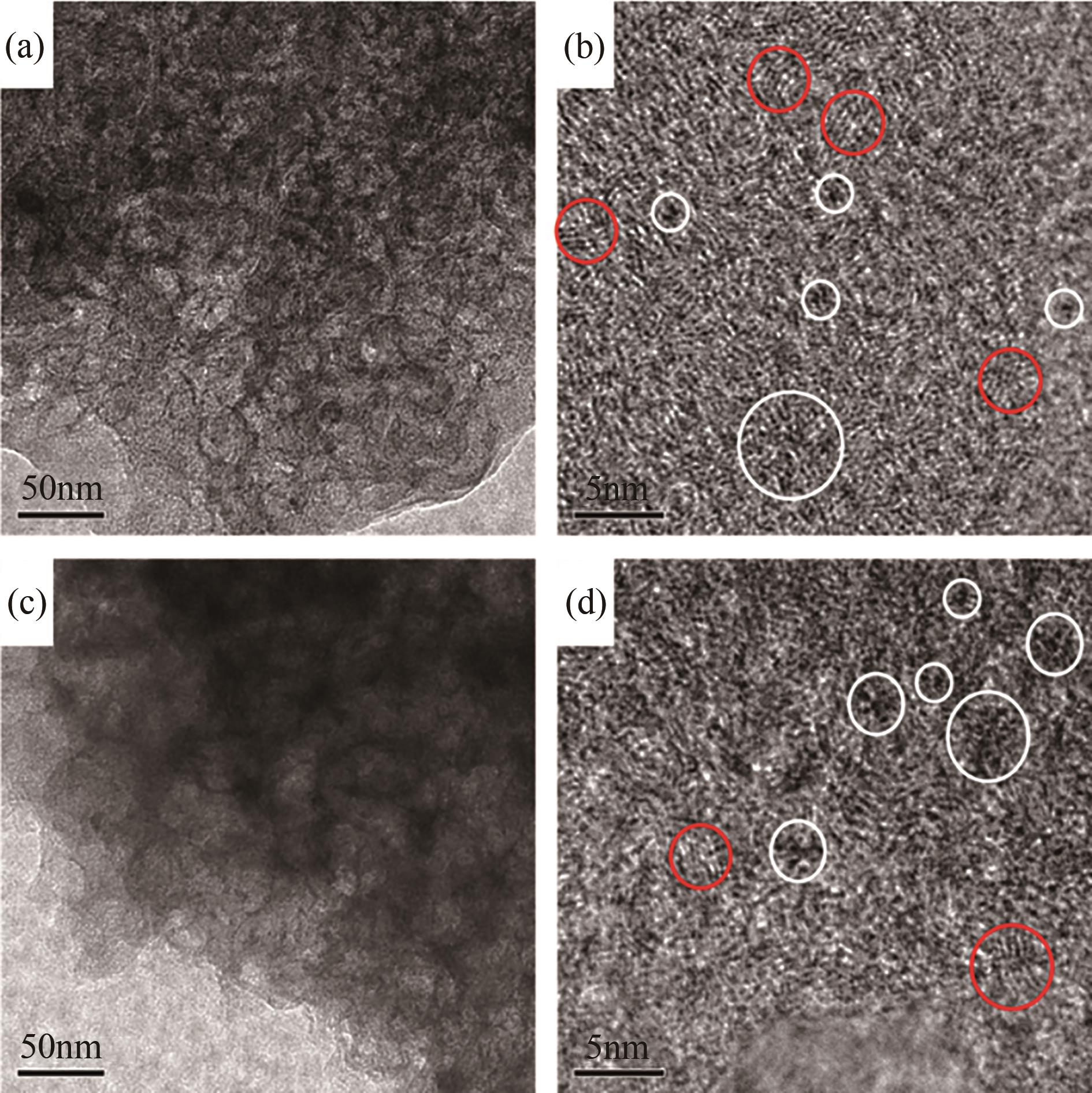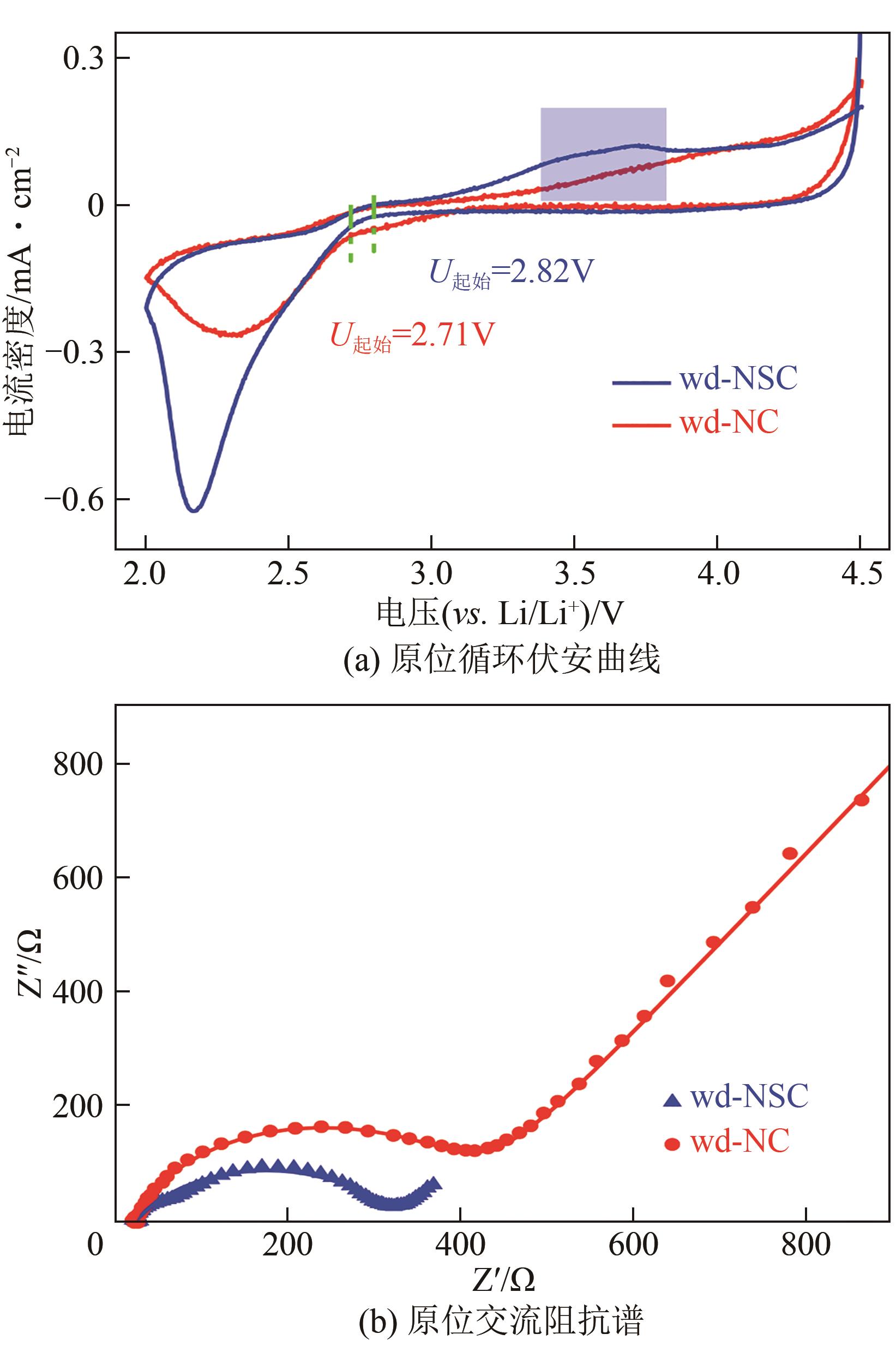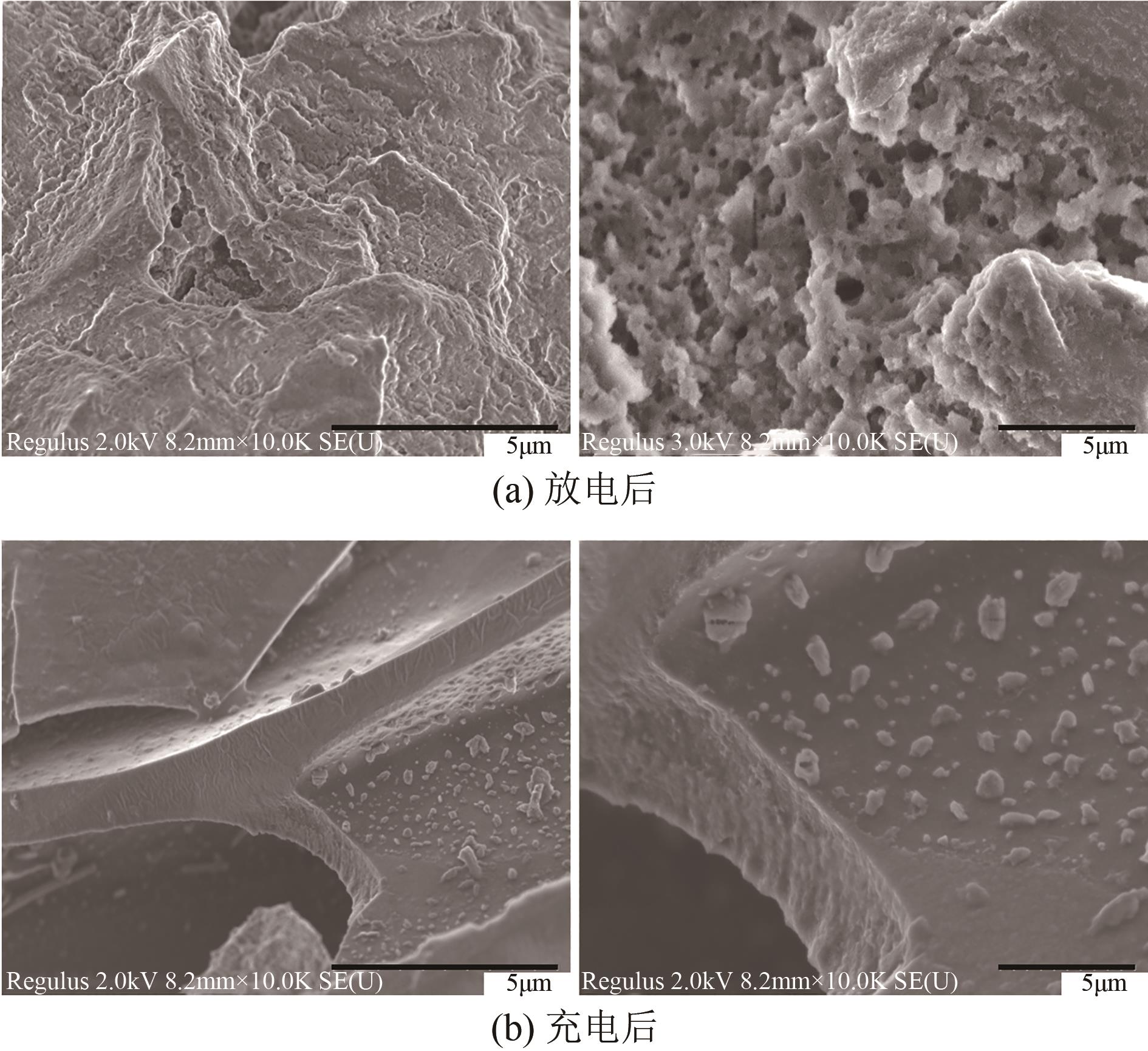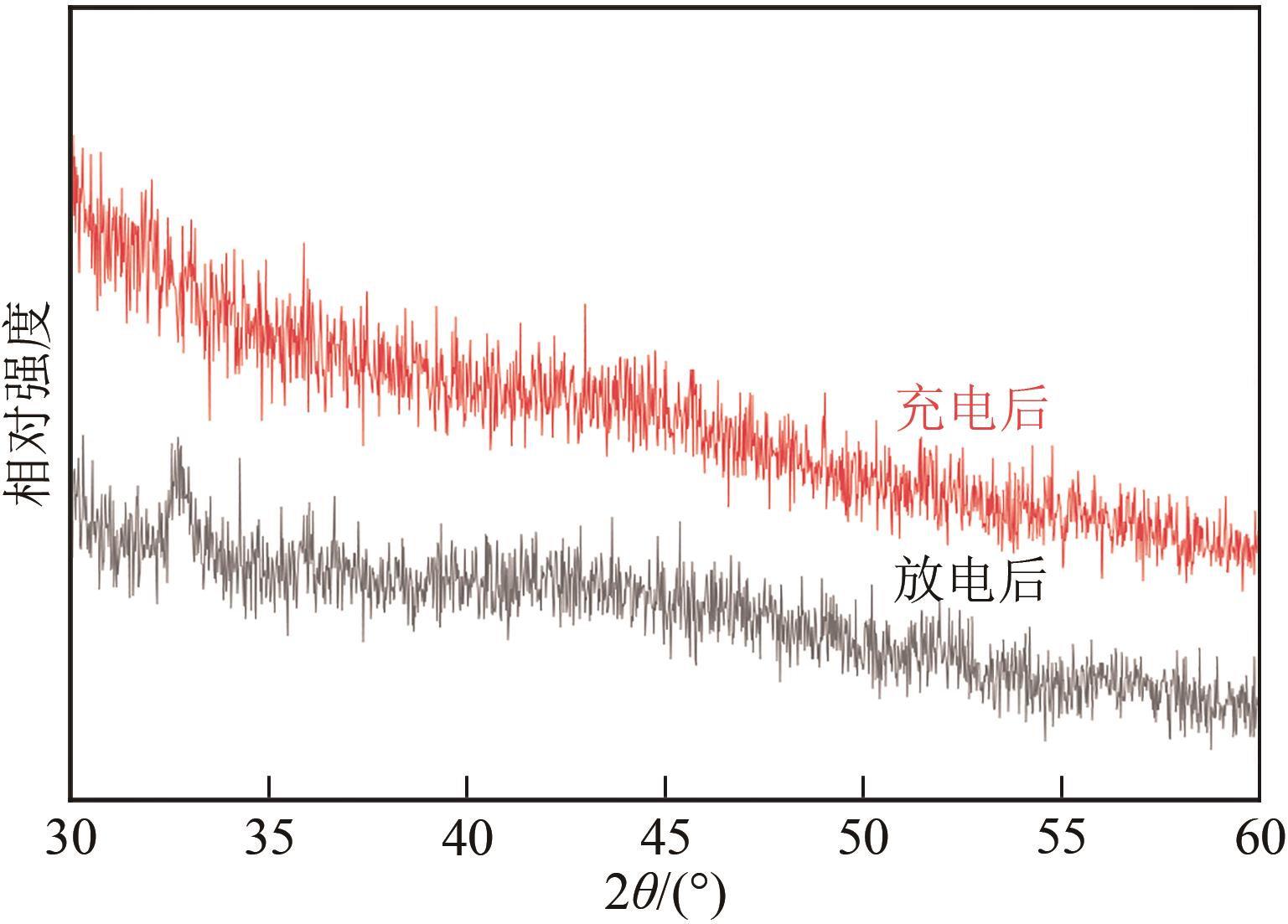Chemical Industry and Engineering Progress ›› 2022, Vol. 41 ›› Issue (5): 2555-2565.DOI: 10.16085/j.issn.1000-6613.2021-1011
• Materials science and technology • Previous Articles Next Articles
Three dimensional self-supporting Co, N, S co-doped porous carbon derived from paulownia wood for Li-O2 batteries
LIANG Huagen1( ), QI Zhengwei2, JIA Linhui1, GAI Zejia2, JING Shengyu2, YIN Shibin3(
), QI Zhengwei2, JIA Linhui1, GAI Zejia2, JING Shengyu2, YIN Shibin3( )
)
- 1.Low Carbon Energy Institute, China University of Mining and Technology, Xuzhou 221008, Jiangsu, China
2.School of Information and Control Engineering, China University of Mining and Technology, Xuzhou 221008, Jiangsu, China
3.College of Chemistry and Chemical Engineering, MOE Key Laboratory of New Processing Technology for Non-ferrous Metals and Materials, Guangxi Key Laboratory of Processing for Non-ferrous Metals and Featured Materials, Guangxi University, Nanning 530004, Guangxi, China
-
Received:2021-05-12Revised:2021-06-17Online:2022-05-24Published:2022-05-05 -
Contact:YIN Shibin
锂-氧气电池用泡桐木衍生三维自支撑Co、N、S共掺杂多孔炭
梁华根1( ), 齐正伟2, 贾林辉1, 盖泽嘉2, 荆胜羽2, 尹诗斌3(
), 齐正伟2, 贾林辉1, 盖泽嘉2, 荆胜羽2, 尹诗斌3( )
)
- 1.中国矿业大学低碳能源研究院,江苏 徐州 221008
2.中国矿业大学信息与控制工程学院,江苏 徐州 221008
3.广西大学化学化工学院,有色金属及材料加工新技术教育部重点实验室,广西有色金属及特色材料加工重点 实验室,广西 南宁 530004
-
通讯作者:尹诗斌 -
作者简介:梁华根(1985—),男,副研究员,研究方向为电催化与能源材料。E-mail:lianghg@cumt.edu.cn 。 -
基金资助:国家自然科学基金(21908242);广西大学有色金属及特色材料加工重点实验室开放基金(2021GXYSOF10)
CLC Number:
Cite this article
LIANG Huagen, QI Zhengwei, JIA Linhui, GAI Zejia, JING Shengyu, YIN Shibin. Three dimensional self-supporting Co, N, S co-doped porous carbon derived from paulownia wood for Li-O2 batteries[J]. Chemical Industry and Engineering Progress, 2022, 41(5): 2555-2565.
梁华根, 齐正伟, 贾林辉, 盖泽嘉, 荆胜羽, 尹诗斌. 锂-氧气电池用泡桐木衍生三维自支撑Co、N、S共掺杂多孔炭[J]. 化工进展, 2022, 41(5): 2555-2565.
share this article
Add to citation manager EndNote|Ris|BibTeX
URL: https://hgjz.cip.com.cn/EN/10.16085/j.issn.1000-6613.2021-1011
| 材料 | SBET/m2·g-1 | Smicro/m2·g-1 | Smeso/m2·g-1 | Vt/cm3·g-1 | Vmicro/cm3·g-1 | Vmeso/cm3·g-1 | daverage/nm |
|---|---|---|---|---|---|---|---|
| wd-NSC | 879.4 | 66.4 | 813.0 | 0.61 | 0.31 | 0.34 | 2.9 |
| wd-NC | 362.1 | 292.2 | 69.9 | 0.19 | 0.12 | 0.09 | 2.3 |
| 材料 | SBET/m2·g-1 | Smicro/m2·g-1 | Smeso/m2·g-1 | Vt/cm3·g-1 | Vmicro/cm3·g-1 | Vmeso/cm3·g-1 | daverage/nm |
|---|---|---|---|---|---|---|---|
| wd-NSC | 879.4 | 66.4 | 813.0 | 0.61 | 0.31 | 0.34 | 2.9 |
| wd-NC | 362.1 | 292.2 | 69.9 | 0.19 | 0.12 | 0.09 | 2.3 |
| 材料 | wC/% | wN/% | wO/% | wS/% | wCo/% |
|---|---|---|---|---|---|
| wd-NSC | 72.68 | 8.07 | 15.96 | 0.96 | 1.29 |
| wd-NC | 82.69 | 5.1 | 10.32 | — | 1.06 |
| 材料 | wC/% | wN/% | wO/% | wS/% | wCo/% |
|---|---|---|---|---|---|
| wd-NSC | 72.68 | 8.07 | 15.96 | 0.96 | 1.29 |
| wd-NC | 82.69 | 5.1 | 10.32 | — | 1.06 |
| 材料 | 电流密度 /mA·cm-2 | 放电比容量 /mA·h·cm-2 | 循环寿命 /次 | 参考文献 |
|---|---|---|---|---|
| N-HMACs-RuO2 | — | 5.36 | 215 | [ |
| CA-wood/Ru | 0.1 | 8.58 | 100 | [ |
| wd-NC | 0.08 | 1.86 | 20 | [ |
| RuO2/WD-C | 0.1 | 8.38 | 200 | [ |
| Wood-D/Co3O4/C | 0.1 | 6 | — | [ |
| SCC-N | 0.05 | — | 61 | [ |
| NiFeP/BC | 0.05 | 10.9 | 90 | [ |
| 本文 | 0.05 | 12.83 | 125 | — |
| 材料 | 电流密度 /mA·cm-2 | 放电比容量 /mA·h·cm-2 | 循环寿命 /次 | 参考文献 |
|---|---|---|---|---|
| N-HMACs-RuO2 | — | 5.36 | 215 | [ |
| CA-wood/Ru | 0.1 | 8.58 | 100 | [ |
| wd-NC | 0.08 | 1.86 | 20 | [ |
| RuO2/WD-C | 0.1 | 8.38 | 200 | [ |
| Wood-D/Co3O4/C | 0.1 | 6 | — | [ |
| SCC-N | 0.05 | — | 61 | [ |
| NiFeP/BC | 0.05 | 10.9 | 90 | [ |
| 本文 | 0.05 | 12.83 | 125 | — |
| 1 | ZHANG P, DING M J, LI X X, et al. Challenges and strategy on parasitic reaction for high-performance nonaqueous lithium-oxygen batteries[J]. Advanced Energy Materials, 2020, 10(40): 2001789. |
| 2 | 吴爱明, 夏国锋, 沈水云, 等. 非水体系锂-空气电池研究进展[J]. 物理化学学报, 2016, 32(8): 1866-1879. |
| WU Aiming, XIA Guofeng, SHEN Shuiyun, et al. Recent progress in non-aqueous lithium-air batteries[J]. Acta Physico-Chimica Sinica, 2016, 32(8): 1866-1879. | |
| 3 | LIU T, VIVEK J P, ZHAO E W, et al. Current challenges and routes forward for nonaqueous lithium-air batteries[J]. Chemical Reviews, 2020, 120(14): 6558-6625. |
| 4 | KWAK W J, ROSY, SHARON D, et al. Lithium-oxygen batteries and related systems: potential, status, and future[J]. Chemical Reviews, 2020, 120(14): 6626-6683. |
| 5 | WANG T J, WANG Y W, CHEN Y H, et al. Developing practical lithium-air batteries by avoiding negative effects of CO2 [J]. Acta Physico Chimica Sinica, DOI: 10.3866/PKU.WHXB202009071 . |
| 6 | WANG H F, WANG X X, LI M L, et al. Porous materials applied in nonaqueous Li-O2 batteries: status and perspectives[J]. Advanced Materials, 2020, 32(44): 2002559. |
| 7 | 王朕, 吴刚, 董鹏, 等. 锂-二氧化碳电池阴极催化剂的研究进展[J]. 化工进展, 2020, 39(9): 3677-3684. |
| WANG Zhen, WU Gang, DONG Peng, et al. Research progress of cathode catalysts for Li-CO2 batteries[J]. Chemical Industry and Engineering Progress, 2020, 39(9): 3677-3684. | |
| 8 | 张英杰, 章艳佳, 曾晓苑, 等. 掺杂碳材料在锂空气电池中的应用研究进展[J]. 化工进展, 2018, 37(3): 1047-1053. |
| ZHANG Yingjie, ZHANG Yanjia, ZENG Xiaoyuan, et al. Review on recent progress of doped carbon materials for Li-air batteries[J]. Chemical Industry and Engineering Progress, 2018, 37(3): 1047-1053. | |
| 9 | 李妍慧, 银凤翔, 何小波, 等. 锂/空气电池非贵金属催化剂研究进展[J]. 化工进展, 2015, 34(11): 3926-3932. |
| LI Yanhui, YIN Fengxiang, HE Xiaobo, et al. Recent progress in non-precious metal catalysts for lithium-air batteries[J]. Chemical Industry and Engineering Progress, 2015, 34(11): 3926-3932. | |
| 10 | JUNG J W, CHO S H, NAM J S, et al. Current and future cathode materials for non-aqueous Li-air (O2) battery technology—A focused review[J]. Energy Storage Materials, 2020, 24: 512-528. |
| 11 | ZHU X B, WU Y G, WAN W H, et al. CNF-grafted carbon fibers as a binder-free cathode for lithium-oxygen batteries with a superior performance[J]. International Journal of Hydrogen Energy, 2018, 43(2): 739-747. |
| 12 | SONG K F, YUAN L F, LI Z X, et al. Tuning MnCo2O4 nanowire arrays on carbon cloth as an efficient cathode catalyst for Li-O2 batteries[J]. Electrochimica Acta, 2020, 353: 136572. |
| 13 | HOU Z Q, SHU C Z, HEI P, et al. Configuration of gradient-porous ultrathin FeCo2S4 nanosheets vertically aligned on Ni foam as a noncarbonaceous freestanding oxygen electrode for lithium-oxygen batteries[J]. Nanoscale, 2020, 12(3): 1864-1874. |
| 14 | DENG J, LI M M, WANG Y. Biomass-derived carbon: synthesis and applications in energy storage and conversion[J]. Green Chemistry, 2016, 18(18): 4824-4854. |
| 15 | BORGHEI M, LEHTONEN J, LIU L, et al. Advanced biomass-derived electrocatalysts for the oxygen reduction reaction[J]. Advanced Materials, 2018, 30(24): 1703691. |
| 16 | ZHAO X, ZHU J B, LIANG L, et al. Biomass-derived N-doped carbon and its application in electrocatalysis[J]. Applied Catalysis B: Environmental, 2014, 154/155: 177-182. |
| 17 | ZENG X Y, LENG L M, LIU F F, et al. Enhanced Li-O2 battery performance, using graphene-like nori-derived carbon as the cathode and adding LiI in the electrolyte as a promoter[J]. Electrochimica Acta, 2016, 200: 231-238. |
| 18 | ZHU X D, SHANG Y, LU Y C, et al. A free-standing biomass-derived RuO2/N-doped porous carbon cathode towards highly performance lithium-oxygen batteries[J]. Journal of Power Sources, 2020, 471: 228444. |
| 19 | XU S M, CHEN C J, KUANG Y D, et al. Flexible lithium-CO2 battery with ultrahigh capacity and stable cycling[J]. Energy & Environmental Science, 2018, 11(11): 3231-3237. |
| 20 | SONG H Y, XU S M, LI Y J, et al. Hierarchically porous, ultrathick, “breathable” wood-derived cathode for lithium-oxygen batteries[J]. Advanced Energy Materials, 2018, 8(4): 1701203. |
| 21 | QIAO Y, XU S M, LIU Y, et al. Transient, in situ synthesis of ultrafine ruthenium nanoparticles for a high-rate Li-CO2 battery[J]. Energy & Environmental Science, 2019, 12(3): 1100-1107. |
| 22 | ZHU Y S, ZHANG B S. Nanocarbon-based metal-free and non-precious metal bifunctional electrocatalysts for oxygen reduction and oxygen evolution reactions[J]. Journal of Energy Chemistry, 2021, 58: 610-628. |
| 23 | LIANG H G, JIA L H, CHEN F. Three-dimensional self-standing Co@NC octahedron/biochar cathode for non-aqueous Li-O2 batteries: efficient catalysis for reversible formation and decomposition of LiOH[J]. Journal of Materials Science, 2020, 55(18): 7792-7804. |
| 24 | LIANG H G, ZHANG Y L, CHEN F, et al. A novel NiFe@NC-functionalized N-doped carbon microtubule network derived from biomass as a highly efficient 3D free-standing cathode for Li-CO2 batteries[J]. Applied Catalysis B: Environmental, 2019, 244: 559-567. |
| 25 | JING S Y, ZHANG Y L, CHEN F, et al. Novel and highly efficient cathodes for Li-O2 batteries: 3D self-standing NiFe@NC-functionalized N-doped carbon nanonet derived from Prussian blue analogues/biomass composites[J]. Applied Catalysis B: Environmental, 2019, 245: 721-732. |
| 26 | LIANG H G, CHEN F, ZHANG M S, et al. Highly performing free standing cathodic electrocatalysts for Li-O2 batteries: CoNiO2 nanoneedle arrays supported on N-doped carbon nanonet[J]. Applied Catalysis A: General, 2019, 574: 114-121. |
| 27 | LIANG H G, GONG X, JIA L H, et al. Highly efficient Li-O2 batteries based on self-standing NiFeP@NC/BC cathode derived from biochar supported Prussian blue analogues[J]. Journal of Electroanalytical Chemistry, 2020, 867: 114124. |
| 28 | JING S Y, ZHANG M S, LIANG H G, et al. Facile synthesis of 3D binder-free N-doped carbon nanonet derived from silkworm cocoon for Li-O2 battery[J]. Journal of Materials Science, 2018, 53(6): 4395-4405. |
| 29 | LI Y P, CI S Q, CAI P W, et al. Thermally stable cobalt amide cyanide as high-activity and durable bifunctional electrocatalyst toward O2 and CO2 reduction[J]. Electrochimica Acta, 2020, 353: 136605. |
| 30 | YU H, SUN X Y, TANG D H, et al. Molten salt strategy to synthesize alkali metal-doped Co9S8 nanoparticles embedded, N, S co-doped mesoporous carbon as hydrogen evolution electrocatalyst[J]. International Journal of Hydrogen Energy, 2020, 45(11): 6006-6014. |
| 31 | PERAZZOLO V, DURANTE C, PILOT R, et al. Nitrogen and sulfur doped mesoporous carbon as metal-free electrocatalysts for the in situ production of hydrogen peroxide[J]. Carbon, 2015, 95: 949-963. |
| 32 | ZHANG J, CHEN J W, LUO Y, et al. A defect-driven atomically dispersed Fe-N-C electrocatalyst for bifunctional oxygen electrocatalytic activity in Zn-air batteries[J]. Journal of Materials Chemistry A, 2021, 9(9): 5556-5565. |
| 33 | WU Y, YANG Y, GAO T T, et al. Ligand regulation to prepare an Fe, N, S tri-codoped hollow carbon electrocatalyst for enhanced ORR performance and Zn-air batteries[J]. Sustainable Energy & Fuels, 2020, 4(8): 4117-4125. |
| 34 | ZOU J, WANG B, ZHU B, et al. Fe, N, S-codoped carbon frameworks derived from nanocrystal superlattices towards enhanced oxygen reduction activity[J]. Nano Convergence, 2019, 6(1): 4. |
| 35 | GAO J, LIU S, ZHU P, et al. Fe-N4 engineering of S and N co-doped hierarchical porous carbon-based electrocatalysts for enhanced oxygen reduction in Zn-air batteries[J]. Dalton Transactions, 2020, 49(42): 14847-14853. |
| 36 | AL-SHAHAT EISSA A, KIM N H, LEE J H. Rational design of a highly mesoporous Fe-N-C/Fe3C/C-S-C nanohybrid with dense active sites for superb electrocatalysis of oxygen reduction[J]. Journal of Materials Chemistry A, 2020, 8(44): 23436-23454. |
| 37 | FENG M J, ZHANG Q, SUN S G, et al. In-situ synthesis of Fe, N, S co-doped graphene-like nanosheets around carbon nanoparticles with dual-nitrogen-source as efficient electrocatalyst for oxygen reduction reaction[J]. International Journal of Hydrogen Energy, 2021, 46(11): 8002-8013. |
| 38 | SONG S Q, WU M M, CHEN J W, et al. An Fe-N/S-C hybrid electrocatalyst derived from bimetal-organic framework for efficiently electrocatalyzing oxygen reduction reaction in acidic media[J]. Journal of Energy Chemistry, 2021, 52: 291-300. |
| 39 | DAI P, XUE Y, ZHANG S, et al. Paper-derived flexible 3D interconnected carbon microfiber networks with controllable pore sizes for supercapacitors[J]. ACS Applied Materials & Interfaces, 2018, 10(43): 37046-37056. |
| 40 | SHEN H J, GRACIA-ESPINO E, MA J Y, et al. Synergistic effects between atomically dispersed Fe-N-C and C-S-C for the oxygen reduction reaction in acidic media[J]. Angewandte Chemie International Edition, 2017, 129(44): 13988-13992. |
| 41 | SABHAPATHY P, SHOWN I, SABBAH A, et al. Electronic structure modulation of isolated Co-N4 electrocatalyst by sulfur for improved pH-universal hydrogen evolution reaction[J]. Nano Energy, 2021, 80: 105544. |
| 42 | NI B X, CHEN R, WU L M, et al. Optimized enhancement effect of sulfur in Fe-N-S codoped carbon nanosheets for efficient oxygen reduction reaction[J]. ACS Applied Materials & Interfaces, 2020, 12(21): 23995-24006. |
| 43 | ZHONG J P, HOU C, LI L, et al. A novel strategy for synthesizing Fe, N, and S tridoped graphene-supported Pt nanodendrites toward highly efficient methanol oxidation[J]. Journal of Catalysis, 2020, 381: 275-284. |
| 44 | NAVEEN M H, SHIM K, HOSSAIN M S A, et al. Template free preparation of heteroatoms doped carbon spheres with trace Fe for efficient oxygen reduction reaction and supercapacitor[J]. Advanced Energy Materials, 2017, 7(5): 1602002. |
| 45 | HUO S L, NI W, ZHAO Y F, et al. Highly efficient atomically dispersed Co-N active sites in porous carbon for high-performance capacitive desalination of brackish water[J]. Journal of Materials Chemistry A, 2021, 9(5): 3066-3076. |
| 46 | LIANG Z Z, KONG N N, YANG C X, et al. Highly curved nanostructure-coated Co, N-doped carbon materials for oxygen electrocatalysis[J]. Angewandte Chemie International Edition, 2021, 60(23): 12759-12764. |
| 47 | HUANG K X, LI J, SUN M L, et al. PEDOT functionalized ZIF-67 derived Co-N-S triple-doped porous carbon for high-efficiency oxygen reduction[J]. Applied Surface Science, 2021, 535: 147659. |
| 48 | ZHANG W M, CHU J J, LI S F, et al. CoN x C active sites-rich three-dimensional porous carbon nanofibers network derived from bacterial cellulose and bimetal-ZIFs as efficient multifunctional electrocatalyst for rechargeable Zn-air batteries[J]. Journal of Energy Chemistry, 2020, 51: 323-332. |
| 49 | SHEN J R, WU H T, SUN W, et al. In-situ nitrogen-doped hierarchical porous hollow carbon spheres anchored with iridium nanoparticles as efficient cathode catalysts for reversible lithium-oxygen batteries[J]. Chemical Engineering Journal, 2019, 358: 340-350. |
| 50 | YUAN M W, ZHANG S T, LIN L, et al. Manganese carbodiimide nanoparticles modified with N-doping carbon: a bifunctional cathode electrocatalyst for aprotic Li-O2 battery[J]. ACS Sustainable Chemistry & Engineering, 2019, 7(20): 17464-17473. |
| 51 | YUAN L F, SONG K F, LIU Z Y, et al. Fe2O3 nanorods decorated with ultrafine CeO2 as binder-free cathode to improve the performance of Li-O2 batteries[J]. Electrochimica Acta, 2021, 368: 137645. |
| 52 | TOMON C, KRITTAYAVATHANANON A, SARAWUTANUKUL S, et al. Enhancing bifunctional electrocatalysts of hollow Co3O4 nanorods with oxygen vacancies towards ORR and OER for Li-O2 batteries[J]. Electrochimica Acta, 2021, 367: 137490. |
| 53 | MONACO S, SOAVI F, MASTRAGOSTINO M. Role of oxygen mass transport in rechargeable Li/O2 batteries operating with ionic liquids[J]. The Journal of Physical Chemistry Letters, 2013, 4(9): 1379-1382. |
| 54 | LUO J R, YAO X H, YANG L, et al. Free-standing porous carbon electrodes derived from wood for high-performance Li-O2 battery applications[J]. Nano Research, 2017, 10(12): 4318-4326. |
| 55 | ZHU C L, DU L, LUO J M, et al. A renewable wood-derived cathode for Li-O2 batteries[J]. Journal of Materials Chemistry A, 2018, 6(29): 14291-14298. |
| 56 | ZHAO G Y, LIU Y F, TANG L, et al. Capacitive behavior based on the ultrafast mass transport in a self-supported lithium oxygen battery cathode[J]. ACS Applied Energy Materials, 2019, 2(3): 2113-2121. |
| 57 | FAN X P, HUANG Y G, WANG H Q, et al. Efficacious nitrogen introduction into MoS2 as bifunctional electrocatalysts for long-life Li-O2 batteries[J]. Electrochimica Acta, 2021, 369: 137653. |
| 58 | ZHANG G Z, YAO Y, ZHAO T, et al. From black liquor to green energy resource: positive electrode materials for Li-O2 battery with high capacity and long cycle life[J]. ACS Applied Materials & Interfaces, 2020, 12(14): 16521-16530. |
| [1] | ZHANG Mingyan, LIU Yan, ZHANG Xueting, LIU Yake, LI Congju, ZHANG Xiuling. Research progress of non-noble metal bifunctional catalysts in zinc-air batteries [J]. Chemical Industry and Engineering Progress, 2023, 42(S1): 276-286. |
| [2] | HU Xi, WANG Mingshan, LI Enzhi, HUANG Siming, CHEN Junchen, GUO Bingshu, YU Bo, MA Zhiyuan, LI Xing. Research progress on preparation and sodium storage properties of tungsten disulfide composites [J]. Chemical Industry and Engineering Progress, 2023, 42(S1): 344-355. |
| [3] | ZHANG Jie, BAI Zhongbo, FENG Baoxin, PENG Xiaolin, REN Weiwei, ZHANG Jingli, LIU Eryong. Effect of PEG and its compound additives on post-treatment of electrolytic copper foils [J]. Chemical Industry and Engineering Progress, 2023, 42(S1): 374-381. |
| [4] | XU Chunshu, YAO Qingda, LIANG Yongxian, ZHOU Hualong. Research progress on functionalization strategies of covalent organic frame materials and its adsorption properties for Hg(Ⅱ) and Cr(Ⅵ) [J]. Chemical Industry and Engineering Progress, 2023, 42(S1): 461-478. |
| [5] | GAO Yanjing. Analysis of international research trend of single-atom catalysis technology [J]. Chemical Industry and Engineering Progress, 2023, 42(9): 4667-4676. |
| [6] | LEI Wei, JIANG Weijia, WANG Yugao, HE Minghao, SHEN Jun. Synthesis of N,S co-doped coal-based carbon quantum dots by electrochemical oxidation and its application in Fe3+ detection [J]. Chemical Industry and Engineering Progress, 2023, 42(9): 4799-4807. |
| [7] | LI You, WU Yue, ZHONG Yu, LIN Qixuan, REN Junli. Pretreatment of wheat straw with acidic molten salt hydrate for xylose production and its effect on enzymatic hydrolysis efficiency [J]. Chemical Industry and Engineering Progress, 2023, 42(9): 4974-4983. |
| [8] | WU Haibo, WANG Xilun, FANG Yanxiong, JI Hongbing. Progress of the development and application of 3D printing catalyst [J]. Chemical Industry and Engineering Progress, 2023, 42(8): 3956-3964. |
| [9] | WANG Yaogang, HAN Zishan, GAO Jiachen, WANG Xinyu, LI Siqi, YANG Quanhong, WENG Zhe. Strategies for regulating product selectivity of copper-based catalysts in electrochemical CO2 reduction [J]. Chemical Industry and Engineering Progress, 2023, 42(8): 4043-4057. |
| [10] | LIU Yi, FANG Qiang, ZHONG Dazhong, ZHAO Qiang, LI Jinping. Cu facets regulation of Ag/Cu coupled catalysts for electrocatalytic reduction of carbon dioxide [J]. Chemical Industry and Engineering Progress, 2023, 42(8): 4136-4142. |
| [11] | LI Runlei, WANG Ziyan, WANG Zhimiao, LI Fang, XUE Wei, ZHAO Xinqiang, WANG Yanji. Efficient catalytic performance of CuO-CeO2/TiO2 for CO oxidation at low-temperature [J]. Chemical Industry and Engineering Progress, 2023, 42(8): 4264-4274. |
| [12] | ZHANG Yajuan, XU Hui, HU Bei, SHI Xingwei. Preparation of NiCoP/rGO/NF electrocatalyst by eletroless plating for efficient hydrogen evolution reaction [J]. Chemical Industry and Engineering Progress, 2023, 42(8): 4275-4282. |
| [13] | WANG Shuaiqing, YANG Siwen, LI Na, SUN Zhanying, AN Haoran. Research progress on element doped biomass carbon materials for electrochemical energy storage [J]. Chemical Industry and Engineering Progress, 2023, 42(8): 4296-4306. |
| [14] | LI Haidong, YANG Yuankun, GUO Shushu, WANG Benjin, YUE Tingting, FU Kaibin, WANG Zhe, HE Shouqin, YAO Jun, CHEN Shu. Effect of carbonization and calcination temperature on As(Ⅲ) removal performance of plant-based Fe-C microelectrolytic materials [J]. Chemical Industry and Engineering Progress, 2023, 42(7): 3652-3663. |
| [15] | CHU Tiantian, LIU Runzhu, DU Gaohua, MA Jiahao, ZHANG Xiao’a, WANG Chengzhong, ZHANG Junying. Preparation and chemical degradability of organoguanidine-catalyzed dehydrogenation type RTV silicone rubbers [J]. Chemical Industry and Engineering Progress, 2023, 42(7): 3664-3673. |
| Viewed | ||||||
|
Full text |
|
|||||
|
Abstract |
|
|||||










